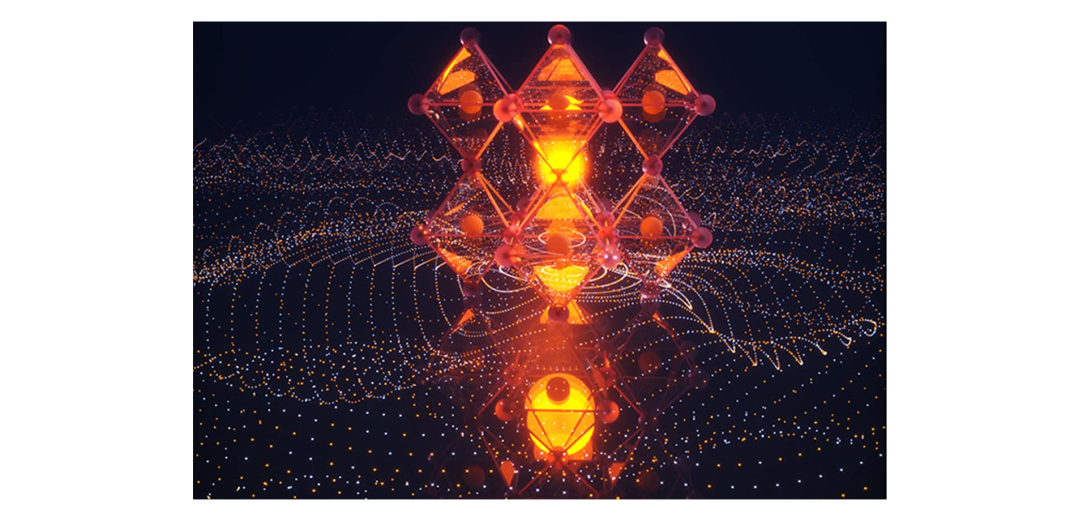A Nature article unravels superfluorescence in perovskites
 Superfluorescence in prerovskites. Artist's view. Credit: Ella Maru Studios.
Superfluorescence in prerovskites. Artist's view. Credit: Ella Maru Studios.
Quantum physics is full of surprising phenomena. One of these is superfluorescence. Photoluminescence, or fluorescence, is the spontaneous emission of light by a material that has been illuminated (by a laser, UV lamp, daylight, etc.). In superfluorescence, this effect is amplified when the microscopic constituents of the material act in unison to generate spontaneous light emission in more exotic forms, i.e. in ultra-short, random pulses.
Collective effects
Imagine a multitude of birds flocking together in a cloud, moving as a single organism. Quantum physics allows for such collective effects (superfluorescence, superconductivity, superfluidity, among others), with mechanisms quite different from bird flights! But although superfluorescence was predicted as early as 1954, and has been observed ever since, it remains very difficult to demonstrate and understand in detail, especially in solids.
The article in Nature, a collaboration between researchers from the University of North Carolina, Duke University, Boston University and École Polytechnique, explains why some materials work better than others for superfluorescence.
If this phenomenon is difficult to observe, it's because the quantum effects that make it possible (in particular, entanglement) are highly sensitive to all external perturbations and rapidly disappear (physicists call this “decoherence”). The higher the temperature, the more pronounced this process, which often limits the progress of these phenomena at very low temperatures.
In hybrid perovskites, the microscopic constituents that act together are “excitons”, a term physicists use to designate a pair formed by an electron and a hole (i.e. an absence of an electron in one place). Scientists have shown that, in hybrid perovskites, at room temperature, there can be synchronization between the collective state of the excitons and the vibrations of the material's lattice of atoms (phonons), when the latter is illuminated by a femtosecond laser. This effect promotes superfluorescence.
Modeling superfluorescence
The authors of the study carried out both experiments and theoretical modeling to analyze and confirm this mechanism. This latter is where Vasily Temnov's team at LSI made a major contribution. An essential part of this modeling and simulation was carried out by Antonia Ghita, a former Bachelor's student at École Polytechnique and now a PhD student at the California Institute of Technology. Antonia Ghita came to LSI as part of a summer internship after her first year of Bachelor's studies, then for laboratory research projects (PRL) in 2022-2023. “She's one of the brightest students I've ever met and has fully embraced the theoretical and numerical tools of quantum optics,” says Vasily Temnov, “This confirms the importance of École Polytechnique's unique environment and its research-led teaching method, which enables us to give real research projects to students.”
The scientists intend to continue this collaboration beyond this article in Nature, in order to deepen fundamental understanding of superfluorescence, and why not of other collective quantum phenomena. In the longer term, this could contribute to the development of quantum computing, which is also limited by decoherence. For Vasily Temnov, the next step is to establish a leading ultrafast quantum optics laboratory within the LSI, an initiative already supported by the Physics Department of the École Polytechnique with a new Laboratory Research Project entitled “Quantum Acousto-Magneto-Plasmonics” and the CNRS Tremplin project entitled “Ultrafast Quantum Probe for Acousto-Magneto-Plasmonics”.
L’article scientifique :
Biliroglu, M., Türe, M., Ghita, A. et al. Unconventional solitonic high-temperature superfluorescence from perovskites. Nature 642, 71–77 (2025). https://doi.org/10.1038/s41586-025-09030-x
*LSI: a joint research unit CEA, CNRS, École Polytechnique, Institut Polytechnique de Paris, 91120 Palaiseau, France
 Support l'X
Support l'X